Here we dive into the famous “Excellent Adventure” from Hedgefundie and how to implement it.
Interested in more Lazy Portfolios? See the full list here.
Disclosure: Some of the links on this page are referral links. At no additional cost to you, if you choose to make a purchase or sign up for a service after clicking through those links, I may receive a small commission. This allows me to continue producing high-quality, ad-free content on this site and pays for the occasional cup of coffee. I have first-hand experience with every product or service I recommend, and I recommend them because I genuinely believe they are useful, not because of the commission I get if you decide to purchase through my links. Read more here.
In a hurry? Here are the highlights:
- Hedgefundie
iswas a member of the Bogleheads forum. - Hedgefundie created a thread in February 2019 proposing a 3x leveraged ETF investing strategy based on risk parity using the S&P 500 index (UPRO) and long-term treasury bonds (TMF) held in a 40/60 allocation. The thread later expanded into a Part 2.
- Hedgefundie later updated the strategy's asset allocation in August 2019 to 55/45 UPRO/TMF.
- Extensive backtesting, discussion, and analysis within the thread by members of the Bogleheads forum supports the validity and potential market outperformance of the strategy.
- The proposed strategy calls for quarterly rebalancing.
- Several different protocols/variations of the strategy emerged in the Excellent Adventure thread, including monthly rebalancing, rebalancing bands, and volatility targeting with various lookback periods.
- Some users have added a dash of TQQQ (3x the NASDAQ 100 index) for a minor tech tilt, as Big Tech has had a stellar run recently.
- It is recommended to implement the strategy within a Roth IRA on M1 Finance, to avoid tax implications and to make regular rebalancing seamless and easy.
Disclaimer: While I love diving into investing-related data and playing around with backtests, this is not financial advice, investing advice, or tax advice. The information on this website is for informational, educational, and entertainment purposes only. Investment products discussed (ETFs, mutual funds, etc.) are for illustrative purposes only. It is not a recommendation to buy, sell, or otherwise transact in any of the products mentioned. I always attempt to ensure the accuracy of information presented but that accuracy cannot be guaranteed. Do your own due diligence. I mention M1 Finance a lot around here. M1 does not provide investment advice, and this is not an offer or solicitation of an offer, or advice to buy or sell any security, and you are encouraged to consult your personal investment, legal, and tax advisors. All examples above are hypothetical, do not reflect any specific investments, are for informational purposes only, and should not be considered an offer to buy or sell any products. All investing involves risk, including the risk of losing the money you invest. Past performance does not guarantee future results. Opinions are my own and do not represent those of other parties mentioned. Read my lengthier disclaimer here.
Contents
Video
Prefer video? Watch it here:
Who Is Hedgefundie?
Hedgefundie is was a member of the Bogleheads forum who created a now-famous thread on the forum proposing a 3x leveraged ETF strategy.
What Is the Hedgefundie Strategy?
The Hedgefundie strategy – the wild ride of which is known as “Hedgefundie's Excellent Adventure” – is based on a risk parity allocation of leveraged stocks (3x the S&P 500 index via UPRO) and leveraged long-term treasury bonds (3x the ICE U.S. Treasury 20+ Year Bond Index via TMF). Note that “HFEA” is the shorthand initialism for the name of the strategy, not the ticker for a fund.
Risk parity is a portfolio allocation strategy in which, consistent with Modern Portfolio Theory (MPT), risk is spread evenly among assets within the portfolio by looking at the volatility contributed by each asset, thereby attempting to optimize returns per unit of risk (Sharpe). I explained it more here. Parity between stocks and long treasuries is roughly achieved at 40/60.
The Hedgefundie strategy relies heavily on the negative correlation (or at least, uncorrelation) between stocks and long-term treasury bonds, wherein the bonds provide a buffer during stock drawdowns. Long-term treasuries are chosen precisely because they are more volatile than shorter-duration bonds and because of their degree of negative correlation to stocks, in order to sufficiently counteract the downward movement of a 3x leveraged stocks position in a crash. I delved into these specific benefits of treasury bonds here. This concept is based on the simple historical principle of improving risk-adjusted return (Sharpe) over long periods by holding uncorrelated assets, such as a traditional 60/40 stocks/bonds portfolio, as opposed to 100% stocks. In a nutshell, this is a way to hold UPRO long term in a much more sensible way.
Consistent with the idea of Lifecycle Investing, this heavily-leveraged strategy is better suited for young investors with a long time horizon who can afford to be risky early in their investment horizon. Hedgefundie advocates for treating this strategy like a “lottery ticket” and not using it with a significant portion of your total portfolio value.
Critics and naysayers reflexively exclaim the oft-cited, overblown, platitudinous “Leveraged ETF's aren't meant to be held long-term because of volatility decay,” but, in short, that doesn't concern me. Moreover, that same volatility decay can actually help when upward movement with positive momentum is occurring. I would also argue that as long as you can stomach the volatility, a major drop should [eventually] be followed by a major rebound; 3x hurts on the way down but helps on the way up. UPRO from ProShares and TMF from Direxion were chosen due to their low tracking error and high volume; again, we're getting 300% exposure to the S&P 500 and long-term treasury bonds, respectively.
The proposed strategy calls for quarterly rebalancing. Several different protocols/variations of the strategy emerged as the Excellent Adventure thread progressed, including monthly rebalancing, rebalancing using bands, and volatility targeting with various lookback periods. I'd keep it simple and avoid checking it often; I can see it being very easy to get emotional with this strategy and abandon your plan. It is recommended to implement the strategy within a Roth IRA on M1 Finance, to avoid tax implications and to make regular rebalancing seamless and easy.
I know this sounds saIes pitchy, but if you're wanting to use this strategy in a taxable account, I would argue it makes even more sense to use M1 Finance because if you're choosing to put in new deposits, the system will automatically rebalance the portfolio for you by directing new deposits to buy the underweight asset, thereby allowing you to avoid capital gains taxes that would otherwise be incurred with a manual rebalance. This is more impactful than it might sound at first. These are 3x leveraged ETFs; they can very quickly get out of balance. For example, let's say you start out at the prescribed 55/45 and stocks take off and bonds suffer, which causes it to stray to 75/25 after only a month. Not good. At this point you'd have to incur short term capital gains taxes (ouch!) just to get things back in balance. Granted, at a certain point, your new deposits may not be sufficiently large enough to provide the full rebalancing effect on their own, but that would be a great problem to have.
Utilizing a traditional, unleveraged 40/60 stocks/bonds portfolio, compared to an all-equities portfolio, has relatively low volatility and should produce higher risk-adjusted return (Sharpe) over long time periods, but would also likely underperform an all-equities portfolio in terms of total return. The solution, Hedgefundie maintains, is applying leverage. We're attempting to accept a risk profile similar to that of the S&P 500, but with much higher expected returns.
Hedgefundie updated the approach 6 months after posting the original strategy, opting to move to a 55/45 UPRO/TMF allocation from the previous 40/60 risk parity allocation. Hedgefundie's reasons are laid out here, based primarily on the premise that the stocks portion of the strategy is the primary driver of the strategy's returns and that the main purpose of holding the treasury bonds is essentially as “insurance” in case of a stock market crash.
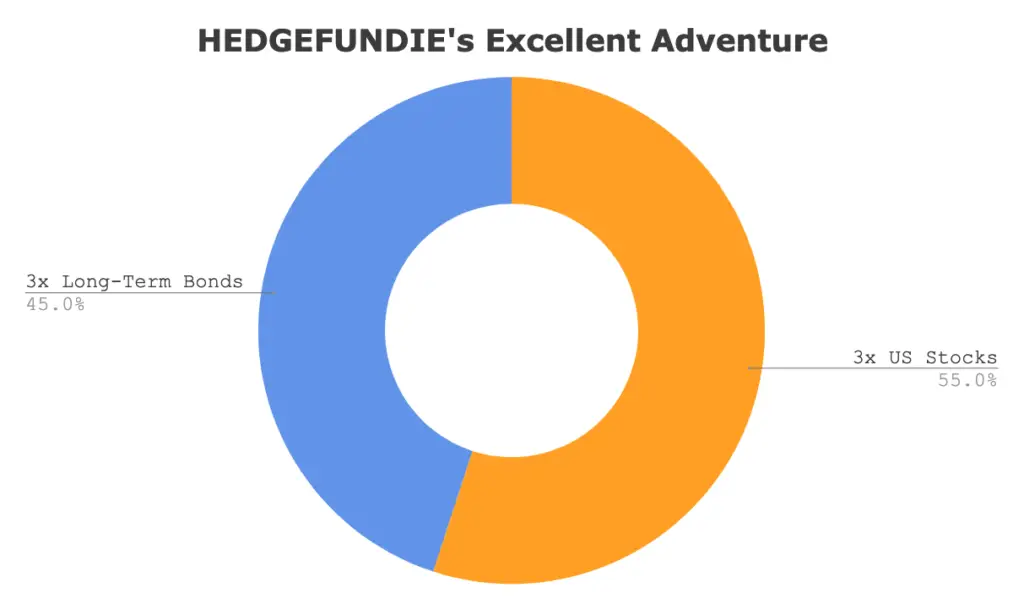
Intrinsically, we're relying on US stocks and long-term treasuries not crashing in tandem. At the time of writing, these assets have a seemingly reliably negative correlation close to -0.5 on average. A key fundamental assumption of this strategy that Hedgefundie proposes is that the US will not return to pre-Volcker (pre-1982) monetary policy. That is, we'll be able to significantly mitigate or altogether avoid runaway inflation periods like the late 1970's, during which time bonds suffered greatly.
Stocks and long-term treasury bonds do not have a perfect -1 correlation. Sometimes they move in the same direction. This is actually a good thing. Historically, when these assets moved in the same direction, it was usually up. On days when stocks dropped, long-term treasuries fairly reliably rose significantly to mitigate the total loss.
Simulated returns going back to 1987 look like this:
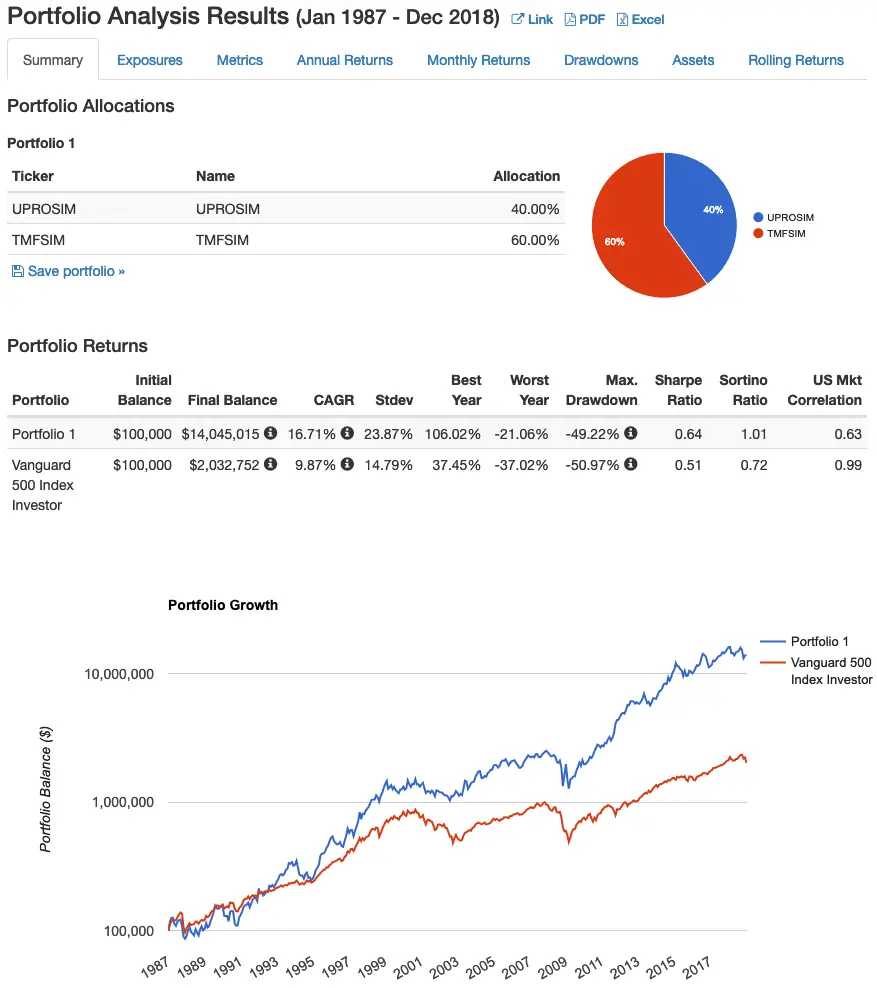
Here are the rolling returns:
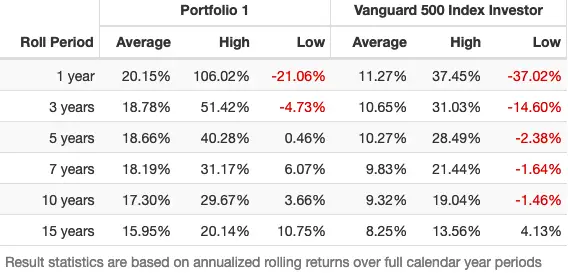
Below are the drawdowns. Notice the smaller drawdowns in most cases compared to the S&P 500:
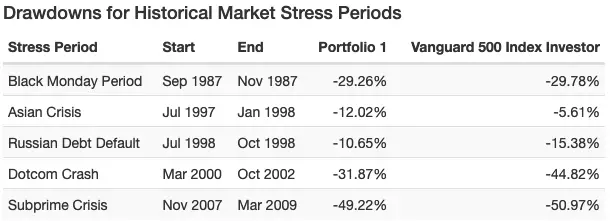
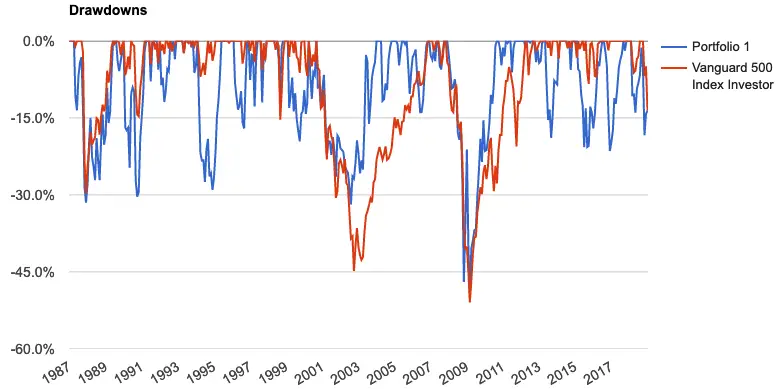
I agree with Hedgefundie's assertion that extremely volatile assets like gold, commodities, small caps, etc. would suffer worse from volatility decay and would not improve the strategy's diversification and return. International developed markets may be a viable option to include, but Boglehead member siamond found issues with the DZK ETF, which ended up closing in October, 2020 anyway.
If you wanted to for some reason, you could also use the slightly more expensive SPXL instead of UPRO. Their liquidity and performance should be nearly identical.
Make no mistake that this is a risky strategy by its very nature. Read up on leverage and the nature of leveraged ETF's before employing this strategy. Do not put your entire portfolio in this strategy.
Read more details and nuances of the strategy on the original thread here. If you've got the time, there's a lot of learning to be had throughout the entire thread. The thread has expanded into a Part 2 here.
UPRO vs. TQQQ
Some users have added a dash of TQQQ (3x the NASDAQ 100 index) for a minor tech tilt, as Big Tech has had a stellar run recently. Others still are using TQQQ as the entire equities position for the HFEA strategy. I personally think this is unnecessary and is purely performance chasing as a product of recency bias.
Imagine for a second that this is January, 2010. After the previous decade, the S&P 500 is down by about 10% for that time period versus the Nasdaq 100 being down about 50%. Would you still be as enthused about TQQQ? Logically, we should be more willing to buy when prices are low, but I’d be willing to bet the honest answer to this question for most folks would be “no.” A rational investor should want to avoid expensive stocks and buy cheap stocks, but this unfortunately isn’t how investors’ highly-emotional brains work.
TQQQ has beaten UPRO historically in terms of sheer performance. But don’t succumb to recency bias. Past performance does not indicate future performance. More importantly, large cap growth stocks are now looking extremely expensive relative to history and are at the valuations we saw in 2000 at the height of the tech bubble, meaning they now have lower future expected returns. To make things worse, fundamentals of these companies do not explain these valuations. The current situation is simply the result of an expansion of price multiples.
Value stocks, on the other hands, are looking extremely cheap, meaning they now have greater expected returns. Of course, we expect Value to outperform every day when we wake up anyway due to what we think is a risk factor premium. If you buy TQQQ, you won’t own any Value stocks. TQQQ is purely large cap growth stocks, the segment with lower expected returns. You also won’t own any small- or mid-cap stocks, which have outperformed large stocks historically.
The valuation spread between Value and Growth was recently as large as it’s ever been. Historically, wide value spreads have also reliably preceded massive outperformance by Value. At the end of the day, we’re still paying for a discounted sum of all future cash flows; Growth cannot get more expensive forever. Unfortunately, there's no leveraged Value ETF.
People like to claim “tech is the future!” That may be true, but that doesn’t have much to do with stock market returns, which are not correlated with GDP. The economy is not the stock market, and the stock market is not the economy. Remember that extremely high expectations for these tech firms are already priced in, and they will have to exceed those expectations in order to beat the market. Moreover, good companies tend to make bad stocks and bad companies tend to make good stocks.
Also remember that you don’t need a “tech tilt” anyway; the market is already over 30% tech at this point. The NASDAQ 100 is basically a tech index at this point; it's realistically about 70% tech, posing a sector concentration risk, which is uncompensated risk.
While I don't employ or condone market timing, we also must acknowledge the fact that we may see rising interest rates sometime in the near future, and TQQQ inherently has more interest rate risk than UPRO. Moreover, TQQQ by definition excludes Financials, which tend to do well when interest rates rise.
Now may be the worst time to overweight large cap growth, but my time machine is broken. Only time will tell which index outperforms. We can’t know the future, but I would argue that’s the reason for broad diversification in the first place.
Why Not 100% UPRO?
If we're expecting UPRO to be the driver of the strategy's returns, why not go 100% UPRO? Hedgefundie addressed this in the original Bogleheads thread by pointing out that in doing so, we'd probably expect super deep drawdowns from which it may take decades to recover. Here's a backtest showing 40/60 UPRO/TMF (Portfolio 1) vs. 100% UPRO (Portfolio 2) to illustrate:
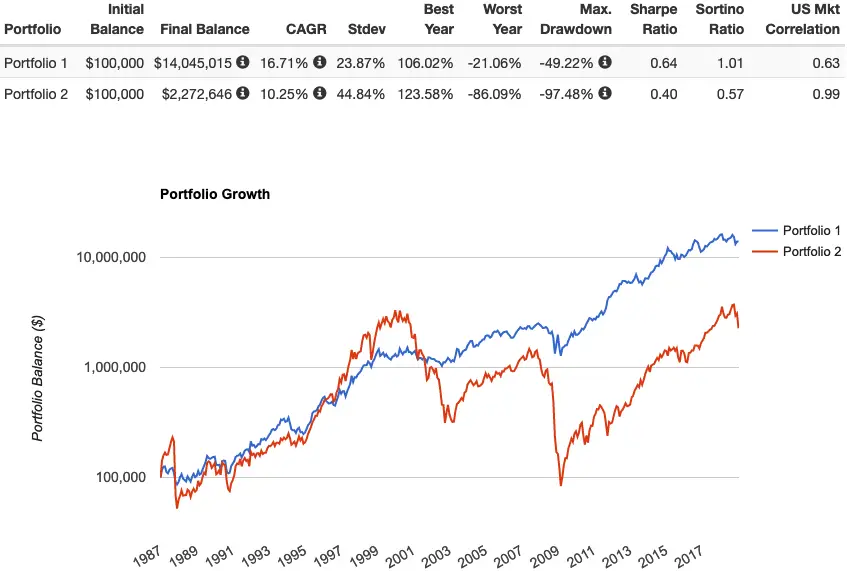
Here's UPRO vs. the S&P 500 going back to 1955:
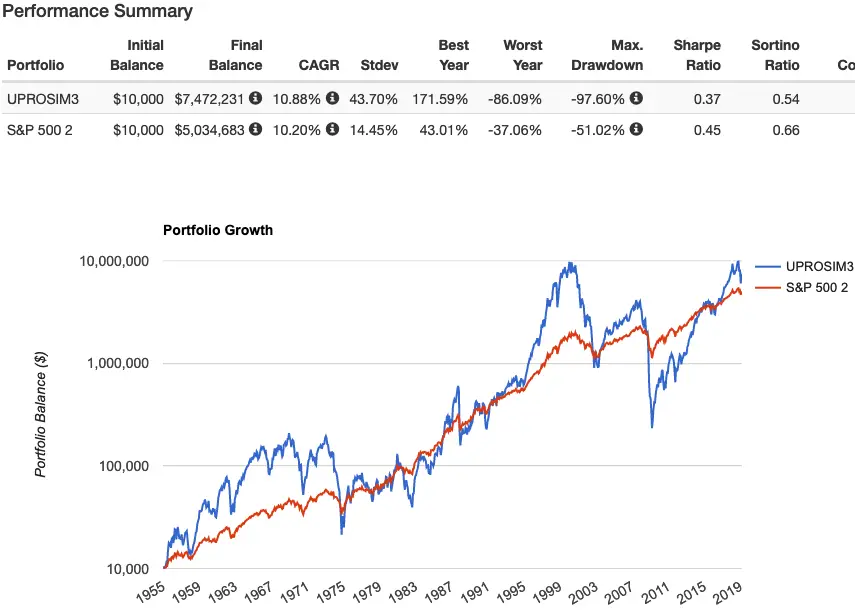
My Hedgefundie Adventure Performance
Tracking the quarterly change in performance (relative to the initial value; no new deposits) of my Hedgefundie Adventure in my own portfolio starting October 1, 2019:
01/01/2020: +7%
04/01/2020: -2%
07/01/2020: +35%
10/01/2020: +54%
01/01/2021: +79%
04/01/2021: +67%
07/01/2021: +105%
10/01/2021: +105%
01/01/2022: +150%
04/01/2022: +98%
07/01/2022: +14%
10/01/2022: -14%
01/01/2023: -10%
04/01/2023: +5%
07/01/2023: +11%
10/01/2023: -14%
01/01/2024: +16%
Alternative Options To the Hedgefundie Portfolio
If you want to utilize a leveraged strategy similar to that proposed by Hedgefundie but be completely hands off, PIMCO has been doing something similar for years with their StocksPLUS Long Duration Fund (PSLDX) since 2007. I reviewed the fund here. Note that you can only access this fund through certain brokers, and it may have a minimum investment requirement and transaction fees. Those details are beyond the scope of this post; ask your broker if it's available to you.
Similarly, if you're doing this with a small portion of your portfolio or if you want to employ a leveraged strategy in a taxable account, WisdomTree's NTSX may be a suitable option, effectively providing 1.5x leverage on a traditional 60/40 stocks/bonds portfolio. It holds 90% straight S&P 500 stocks and 10% treasury futures to achieve effective notional exposure of 90/60 stocks/bonds. I reviewed the fund here.
Bogleheads user MotoTrojan proposed a variant by which you can match the volatility of Hedgefundie's 55/45 UPRO/TMF, tone down the leverage a bit, and save some on the expense ratio of TMF by utilizing Vanguard's Extended Duration Treasury ETF (EDV) in a ratio of 43/57 UPRO/EDV. Here's an M1 pie for that. This variant would also be more tax-efficient than the original strategy that uses TMF if you're doing this in taxable.
Rapidly rising interest rates and/or runaway inflation are the primary risks for this strategy. If those concerns are material to you and make you hesitant about this strategy, or if you simply want more diversification across asset types, then a leveraged All Weather Portfolio may appeal to you. There are also some diversifiers listed below.
Addressing Concerns Over Long-Term Treasury Bonds
I've gotten a lot of questions about – and a lot of the discussion in the original Bogleheads thread has been about – the use, utility, and viability of long-term treasury bonds as a significant chunk of this strategy. I'll briefly address and hopefully quell these concerns below.
Again, by diversifying across uncorrelated assets, we mean holding different assets that will perform well at different times. For example, when stocks zig, bonds tend to zag. Those 2 assets are uncorrelated. Holding both provides a smoother ride, reducing portfolio volatility (variability of return) and risk.
Common comments nowadays about bonds include:
- “Bonds are useless at low yields!”
- “Bonds are for old people!”
- “Long bonds are too volatile and too susceptible to interest rate risk!”
- “Corporate bonds pay more!”
- “Interest rates can only go up from here! Bonds will be toast!”
- “Bonds return less than stocks!”
So why long term treasuries?
- It is fundamentally incorrect to say that bonds must necessarily lose money in a rising rate environment. Bonds only suffer from rising interest rates when those rates are rising faster than expected. Bonds handle low and slow rate increases just fine; look at the period of rising interest rates between 1940 and about 1975, where bonds kept rolling at their par and paid that sweet, steady coupon. Rates also rose steadily from 2016 to mid-2019, during which time TMF delivered a positive return.
- Bond pricing does not happen in a vacuum. Here are some more examples of periods of rising interest rates where long bonds delivered a positive return:
- From 1992-2000, interest rates rose by about 3% and long treasury bonds returned about 9% annualized for the period.
- From 2003-2007, interest rates rose by about 4% and long treasury bonds returned about 5% annualized for the period.
- From 2015-2019, interest rates rose by about 2% and long treasury bonds returned about 5% annualized for the period.
- New bonds bought by a bond index fund in a rising rate environment will be bought at the higher rate, while old ones at the previous lower rate are sold off. You're not stuck with the same yield for your entire investing horizon.
- We know that treasury bonds are an objectively superior diversifier alongside stocks compared to corporate bonds. This is also why I don't use the popular total bond market fund BND. It has been noted that this greater degree of uncorrelation between treasury bonds and stocks is conveniently amplified during periods of market turmoil, which researchers referred to as crisis alpha.
- Again, remember we need and want the greater volatility of long-term bonds so that they can more effectively counteract the downward movement of stocks, which are riskier and more volatile than bonds. We're using them to reduce the portfolio's volatility and risk. More volatile assets make better diversifiers. Most of the portfolio's risk is still being contributed by stocks. Let's use a simplistic risk parity example to illustrate. Risk parity for UPRO and TMF is about 40/60. If we want to slide down the duration scale, we must necessarily decrease UPRO's allocation, as we only have 100% of space to work with. Risk parity for UPRO and TYD (or EDV) is about 25/75. Parity for UPRO and TLT is about 20/80. etc. Simply keeping the same 55/45 allocation (for HFEA, at least) and swapping out TMF for a shorter duration bond fund doesn't really solve anything for us. This is why I've said that while it's not perfect, TMF seems to be the “least bad” option we have, as we can't lever intermediates (TYD) past 3x without the use of futures.
- This one's probably the most important. We're not talking about bonds held in isolation, which would probably be a bad investment right now. We're talking about them in the context of a diversified portfolio alongside stocks, for which they are still the usual flight-to-safety asset during stock downturns. Specifically, for this strategy, the purpose of the bonds side is purely as an insurance parachute in the event of a stock crash. Though they provided a major boost to this strategy's returns over the last 40 years while interest rates were dropping, we're not really expecting any real returns from the bonds side going forward, and we're intrinsically assuming that the stocks side is the primary driver of the strategy's returns. Even if rising rates mean bonds are a comparatively worse diversifier (for stocks) in terms of future expected returns during that period does not mean they are not still the best diversifier to use.
- Similarly, short-term decreases in bond prices do not mean the bonds are not still doing their job of buffering stock downturns.
- Historically, when treasury bonds moved in the same direction as stocks, it was usually up.
- Interest rates are likely to stay low for a while. Also, there’s no reason to expect interest rates to rise just because they are low. People have been claiming “rates can only go up” for the past 20 years or so and they haven't. They have gradually declined for the last 700 years without reversion to the mean. Negative rates aren't out of the question, and we're seeing them used in some foreign countries.
- Bond convexity means their asymmetric risk/return profile favors the upside.
- Again, I acknowledge that post-Volcker monetary policy, resulting in falling interest rates, has driven the particularly stellar returns of the raging bond bull market since 1982, but I also think the Fed and U.S. monetary policy are fundamentally different since the Volcker era, likely allowing us to altogether avoid runaway inflation environments like the late 1970’s going forward. Bond prices already have expected inflation baked in.
David Swensen summed it up nicely in his book Unconventional Success:
“The purity of noncallable, long-term, default-free treasury bonds provides the most powerful diversification to investor portfolios.”
Ok, bonds rant over. If you still feel some dissonance, the next section may offer some solutions.
Reducing Volatility and Drawdowns and Hedging Against Inflation and Rising Rates
It's unlikely that any of the following will improve the total return of the portfolio, and whether or not they'll improve risk-adjusted return is up for debate, but those concerned about inflation, rising rates, volatility, drawdowns, etc., and/or TMF's future ability to adequately serve as an insurance parachute, may want to diversify a bit with some of the following options:
- LTPZ – long term TIPS – inflation-linked bonds.
- FAS – 3x financials – banks tend to do well when interest rates rise.
- EDC – 3x emerging markets – diversify outside the U.S.
- UTSL – 3x utilities – lowest correlation to the market of any sector; tend to fare well during recessions and crashes.
- YINN – 3x China – lowly correlated to the U.S.
- UGL – 2x gold – usually lowly correlated to both stocks and bonds, but a long-term expected real return of zero; no 3x gold funds available.
- DRN – 3x REITs – arguable diversification benefit from “real assets.”
- EDV – U.S. Treasury STRIPS.
- TYD – 3x intermediate treasuries – less interest rate risk.
- UDOW – 3x the Dow – greater loading on Value and Profitability factors than UPRO.
- TNA – 3x Russell 2000 – small caps for the Size factor.
- TAIL – OTM put options ladder to hedge tail risk. Mostly intermediate treasury bonds and TIPS.
- PFIX – OTC payer swaptions on interest rate changes; effectively shorting long bonds.
The Hedgefundie Portfolio ETF Pie for M1 Finance (UPRO/TMF)
Again, most users are utilizing M1 Finance to deploy the Hedgefundie strategy due to its dynamic rebalancing with new deposits, zero transaction fees, and its simple, 1-click rebalance that you can do quarterly. It takes no more than 30 seconds every 3 months. I wrote a comprehensive review of M1 Finance here.
The risk parity 40/60 portfolio would be this pie which looks like this:
- 40% UPRO
- 60% TMF
To add this pie to your portfolio on M1 Finance, just click this link and then click “Save to my account.”
The updated 55/45 portfolio would be this pie which looks like this:
- 55% UPRO
- 45% TMF
To add this pie to your portfolio on M1 Finance, just click this link and then click “Save to my account.”
Canadians can find the above ETFs on Questrade or Interactive Brokers. Investors outside North America can use eToro or possibly Interactive Brokers.
M1 currently has a promotion for up to $500 when initially funding an investment account:
Disclosures: I am long PSLDX, NTSX, UPRO, and TMF in my own portfolio.
Interested in more Lazy Portfolios? See the full list here.
Disclaimer: While I love diving into investing-related data and playing around with backtests, this is not financial advice, investing advice, or tax advice. The information on this website is for informational, educational, and entertainment purposes only. Investment products discussed (ETFs, mutual funds, etc.) are for illustrative purposes only. It is not a recommendation to buy, sell, or otherwise transact in any of the products mentioned. I always attempt to ensure the accuracy of information presented but that accuracy cannot be guaranteed. Do your own due diligence. I mention M1 Finance a lot around here. M1 does not provide investment advice, and this is not an offer or solicitation of an offer, or advice to buy or sell any security, and you are encouraged to consult your personal investment, legal, and tax advisors. All examples above are hypothetical, do not reflect any specific investments, are for informational purposes only, and should not be considered an offer to buy or sell any products. All investing involves risk, including the risk of losing the money you invest. Past performance does not guarantee future results. Opinions are my own and do not represent those of other parties mentioned. Read my lengthier disclaimer here.

Are you nearing or in retirement? Use my link here to get a free holistic financial plan from fiduciary advisors at Retirable to manage your savings, spend smarter, and navigate key decisions.
Don't want to do all this investing stuff yourself or feel overwhelmed? Check out my flat-fee-only fiduciary friends over at Advisor.com.


John – What do you think of a 60/30/10 UPRO/TMF/UTSL. After back testing this strategy amongst many variations of the Hedge Fundie strategy it seems to outperform with not much cost to Sharpe or max draw down. Although I couldn’t really test past 2017 so not huge sample. I did read the AWP article. I’m thinking with the outlook on bonds this could add a little more diversification and wonder maybe a better tilt to the 55/45 hedge fundie. Or is this too much 3x leverage on US equites. Overall portfolio slightly over 2x which has shown to be historically not optimal, (Alpha Generation and Risk Smoothing using Managed, Volatility – Tony Cooper ).
Yea, terribly short time period and data mining. I do like the idea of extra diversifiers thrown in if one has doubts about bonds going forward. Possibly TAIL and UGL as well.
Hi John,
Thanks for updating your performance since 2020. I’m wondering if you might be willing to update the charts in this thread too. Would be great to see the impact of the pandemic and the recent correction in the data.
Thanks for the great information!
Tyler
Thanks, Tyler! Good idea! I need to do that.
If most people use this as a “lottery ticket” as you say portion of their portfolio (5-10%), I’m wondering what is typical when something like this goes on a run and severely misbalances the portfolio (kind of like crypto could).
Do most people just let it run at that point, or sell out of it to rebalance. Since this is supposed to be an ultra-long term investment, curious what happens when exponential growth puts it far outside those 5-10% bands.
If it allowed me to hit my retirement number, I’d sell and exit. Until then, there’s not much of a reason to take profits to rebalance the other “main” portfolio. That’s the whole point of it being a separate lottery ticket in the first place.
You mention this as a “lottery ticket” portion of your portfolio. What percentage of a portfolio do most people (or yourself) consider that? 5-10%?
Yep, 10% is what I’ve seen most people doing.
I am very interested in older data. We had our 40 years of lower interest rates and now reached again 0% like in the 30s. This is a 90-100year long-term debt cycle, like Ray Dalio calls it. Interest rates will behave like a “pyramid scheme”, where they reach their absolute high in the mid of the long-term debt cycle (1980). therefore, period 1940 – 1980 is absolutely different from period 1980 -2020. While the later period was characterized by decreasinginterest rates over decades, hence debt rising, the first period (1940-1980) was characterized by rising interest rates, hence debt was paid back.
As we are reaching record-high amount of debts, both for household and governments (measured in debt/gdp), data for this scenario is strongly supported.
I’d therefore not invest in this strategiy, at least as long as I do not know how it would have behaved in 1940 – 1980.
I know you never time the market, but is there any reason to think right now is a particularly good or bad time to start this strategy? Does leverage have different rules?
Impossible to say. Best time to plant a tree was 20 years ago; second best time is today.
Great website and article. Has there been any back-testing on threshold-band-based rebalancing instead of quarterly. Rebalance at 10 or 15, i.e., if we start at 55/45, rebalance at 65/35 or 45/55.
have been thinking the same on AWP x 3
How would you compare the three ways of going about this strategy? Is there a reason you utilize all three?
UPRO/TMF vs. PDLDX vs. NTSX? Is UPRO route the most risk/reward and NTSX the least?
Tax efficiency and simplicity.
It seems the current environment is the worst-case scenario for this strategy: rapidly rising rates, falling equity prices, and rising inflation. Any update on its performance?
Yes, this was always the achilles heel of this strategy. Quarter isn’t over yet. Give me a few days to update performance. I’m still up nearly 100% from late 2019.
Do I have any downside in doing this in the Traditional IRA vs Roth IRA? Rebalancing Traditional IRA wouldn’t trigger a tax event correct?
I’m new to US retirement. Much appreciated!
Correct, Mark. Fine for Traditional or Roth IRA.
It looks like TMF is not providing much non-correlation lately. Wouldn’t 40-45% cash be a better hold than TMF?
Impossible to know the future. Holding cash effectively just means you’re taking on less equities leverage. We’re seeing high inflation in the face of rising interest rates. This was always the achilles heel of this strategy, and was discussed at length in the original thread. Not to mention a war happening at the same time. This is a long-term strategy of necessity.
Awesome article, thanks for the write up. How would the 55/45 split compare to the 40/60 split and 100% UPRO in the “why not 100% UPRO” segment?
Whoops never mind the last part of my question – quarterly!
Hi John,
Thanks for your great insights! I’m wondering what your thoughts are about substituting SPXU for TMF in some proportion since it would be even more consistently inversely correlated with UPRO. Also, how frequently do you recommend rebalancing Hedgefundie?
Jack, SPXU is just the inverse of UPRO. The sum of their returns would be zero. We don’t want a perfect -1 correlation.
HI, how to perform quarterly rebalancing if your income doesn’t allow you contribute to roth ira account? I am worried quarterly rebalancing would lead to heavy tax implications.
Do a backdoor Roth if you can. In taxable, if you are regularly depositing, you can buy the underweight asset with new deposits (automatic if using M1) until the point at which deposits are not sufficiently large enough to rebalance. The strategy is not meant to be used in a taxable account.
Thanks a bunch for this! Now I’m going to go and hop on M1 and get levered to the ****!
This is a wonderful presentation of a fascinating strategy.
Given the current market conditions with FED clearly tilting towards a less accommodative stance, do you still think HFEA will be a good long term strategy to implement? In an environment with interest rate hikes and -most importantly- the FED offloading their balance sheet, will this strategy be able to continue to outperform the indexes?
Thanks! Impossible to say.
Hello from the UK, I love your website been looking for something like this for a long, rather than the trial and error I have been doing for a long time.
Do you know of any UK (GBP) traded ETF’s I can use please. I can’t use US ETF’s because the currency exchange fee that brokers charge in the UK are sky high.
Thanks,
D
The investing posts on this website have been extremely helpful to me; thank you! I am wondering what your thoughts are on this 55/45 HFEA vs SSO? Would their risk be considered similar? Which do you think would have a greater return when backtesting?
Your post on diversification was very informative; before reading the post, I would say that I was definitely very US biased. Could one diversify 55/45 HFEA to also include ex-US stocks? Have you considered backtesting your more aggressive Ginger Ale with 55/45 HFEA replacing VOO?
55/45 HFEA – 30%
AVUV – 30%
VEA – 10%
AVDV – 10%
VWO – 10%
DGS – 10%
Thanks! I’d be more likely to go HFEA than SSO. We can show empirically that the former is more efficient, which we’d expect. SSO has more risk by being a single asset. We get a big diversification benefit when we include uncorrelated assets. To answer your performance question, HFEA has had greater general and risk-adjusted returns historically than 200% equities.
Can we diversify HFEA with ex-US stocks? Yes, but the liquidity isn’t great. In the section on diversifiers I mentioned EDC and EURL.
Have I considered including HFEA in the Ginger Ale as a replacement for VOO? No. That wouldn’t make much sense.
John, great article! Thanks!
Do you think NTSX at 2x margin would be more efficient than UPRO/TMF in a taxable account to reduce taxes and fees?
Thanks, Eugene! Inarguably yes it would, but I don’t think any broker is going to let you lever it up that much, so it’s probably just a theoretical idea.
Seeing TMF dropping 7.53% today. As well as having much more information on rate hikes compared to when the strategy was created. Do you think we should make any adjustment to the 60/40 ratio or maybe even drop TMF altogether in fear of the coming rate hikes?
I am scared.
I meant 55/45 sorry.
No. If you’re having these thoughts from a single day of <10% movement, this strategy is not for you.
John, Fantastic blog and advice. Truly appreciated. I am curious for your perspective on dollar-cost averaging. Would you recommend investing $10,000 55/45 and rebalancing quarterly, or $833 per month and rebalancing monthly? Thank you.
Impossible to say. Here’s my post on DCA.
Great info here, thanks!
I put 25% of my portfolio in HedgeFundie in early Oct., but I chose TQQQ over UPRO. “Plastics” will always lead… It’s volatile but on track for a nice 20% up quarter. 🙂
Q: Why not simplify further and go 50/50 with HedgeFundie? Why 55/45? Has 50/50 been backtested? Thanks!
55/45 was optimal historically IIRC. TQQQ is not Hedgefundie; it was discussed at length in the original thread.
I recall 55% was chosen in order to allow the 55 to carry the returns of the portfolio even if the 45 was just in cash.
45 is not in cash for HFEA.
Love the article John – a couple of questions.
1) It looks as though the drawdown in this understated as it only calculates the month-end draw downs. In 2020 the actual draw down in March of that year reached ~ 44%. Are you aware of any site that can calculate the in-month drawdowns when doing back testing (looks like potfolio visualizer does only month-end)
2) Are you aware of any brokers in Canada that do automatic rebalancing without any intervention?
Thanks and keep up the great work!
James
Thanks, James. 1. I don’t off the top of my head. 2. I’m not. Possibly Wealthsimple?
Looking forward to try this strategy with my next Roth IRA contribution assuming that I can still use the backdoor method. I still dont understand why its not advocated to buy the global market instead of using UPRO only. I was thinking of doing this:
55% 3x Stocks 45% 3x 20+ US Treasury Bonds (AS HF does it)
In that 55% stocks, I am thinking of doing 70% US 30% INT
70% UPRO
15% EDC
15% EURL
I know UPRO and EURL will be correlated but we don’t know which one will perform better and so I would rather have both. I understand the liquidity issues and there is a chance EURL might close down but is there any other downsides of having EURL in your portfolio?